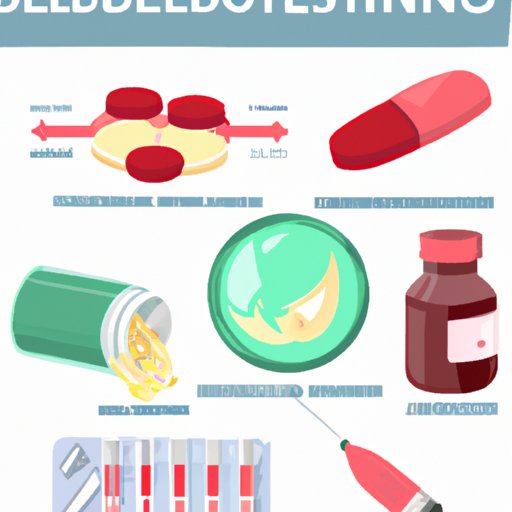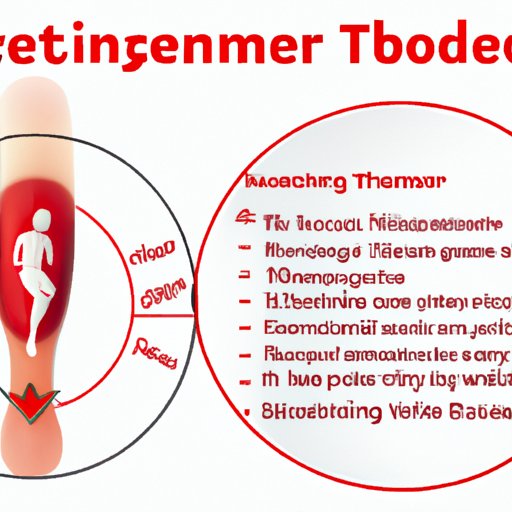
Introduction
Blood thinners are a medication often prescribed to those at risk of blood clots or stroke. While they can be beneficial, they also come with hidden dangers, including internal bleeding. This article will explore the symptoms of internal bleeding from blood thinners, the importance of recognizing these symptoms, and ways to prevent or manage them.
The Hidden Dangers of Blood Thinners: Recognizing Internal Bleeding Symptoms
Blood thinners impede the body’s natural clotting process, making it easier to bleed internally. Internal bleeding can occur anywhere in the body and is often difficult to recognize. Symptoms of internal bleeding may be different depending on the location, but common signs include:
- Abdominal pain or swelling
- Chest pain or shortness of breath
- Unexpected bruising or bleeding
- Headaches or changes in vision
- Dizziness or fainting
- Blood in urine or stool
It is important to seek medical attention immediately if any of these symptoms appear, as internal bleeding can quickly become life-threatening.
When Blood Thinners Go Wrong: Identifying Symptoms of Internal Bleeding
Let’s take a closer look at each of these symptoms and what can cause them:
Abdominal pain or swelling
Internal bleeding within the abdominal cavity can cause pain and swelling. This can be caused by a ruptured organ or blood vessels, a bleeding ulcer, or hemorrhoids. Symptoms may include a bloated feeling, nausea, or vomiting, and patients may also experience pain in the chest or shoulders.
Chest pain or shortness of breath
Internal bleeding within the chest cavity can cause chest pain, shortness of breath, or difficulty breathing. This can be caused by a ruptured aortic aneurysm, chest trauma, or a punctured lung. Patients may also experience a rapid pulse and low blood pressure.
Unexpected bruising or bleeding
Blood thinners can cause bleeding under the skin, which can appear as unexpected bruising or bleeding. This can also cause bleeding from the gums, nose, or gastrointestinal tract. Patients may notice blood in their vomit or stools, or a dark, tar-like stool.
Headaches or changes in vision
If internal bleeding occurs in the brain, it can cause headaches or changes in vision, including blurriness or double vision. Patients may also experience confusion, dizziness, or a loss of consciousness.
Dizziness or fainting
Internal bleeding can cause a patient to feel dizzy or lightheaded, or even faint. This can be caused by blood loss and a drop in blood pressure.
Blood in urine or stool
Internal bleeding in the urinary tract can cause blood to appear in the urine, while bleeding in the digestive tract can cause blood to appear in the stool.
If any of these symptoms appear, it is important to seek medical attention immediately. Depending on the location and severity of the bleeding, treatment may include medication, surgery, or blood transfusions.
Internal Bleeding from Blood Thinners: What You Need to Know
Any patient taking blood thinners is at risk for internal bleeding, but certain factors can increase this risk. These include taking high doses of blood thinners, having a history of bleeding disorders or gastrointestinal ulcers, or taking medications that interact with blood thinners.
Diagnosis often involves physical exams, blood tests, and imaging tests such as CT scans or ultrasounds. Treatment may vary depending on the severity of the bleeding, ranging from medication and rest to surgery.
Patients can reduce the risk of internal bleeding by following their doctor’s instructions regarding dosage and diet, avoiding activities that can increase the risk of injury, and discussing any concerns or side effects with their doctor.
Blood Thinners and Internal Bleeding: Understanding Symptoms and Prevention
Blood thinners work to prevent blood clots from forming, allowing blood to flow more easily through the veins and arteries. This can be critical for those at risk of heart attack, stroke, or other cardiovascular diseases. However, reducing the body’s clotting ability also increases the risk of internal bleeding.
To prevent or manage internal bleeding symptoms, patients can take additional precautions such as avoiding alcohol and smoking, eating a balanced diet rich in Vitamin K, and avoiding activities that can cause injury.
Uncovering the Signs of Internal Bleeding Caused by Blood Thinners
Let’s take another look at the symptoms of internal bleeding caused by blood thinners and possible underlying conditions:
Abdominal pain or swelling
In addition to the causes previously listed, gastrointestinal bleeding can be caused by inflammatory bowel disease, diverticulitis, or cancer. Regular monitoring and preventative screening can help reduce the risk of these conditions.
Chest pain or shortness of breath
Bleeding in the chest can be caused by chest trauma, a blood clot, or abnormalities in the blood vessels. Early detection and treatment are critical to prevent further complications.
Unexpected bruising or bleeding
This symptom can be caused by a variety of conditions, including leukemia, liver disease, or medications that interfere with blood clotting. It is important to discuss any new or unusual symptoms with a medical professional.
Headaches or changes in vision
Bleeding in the brain can be caused by high blood pressure, an aneurysm, or a stroke. Patients with a history of these conditions should be especially cautious when taking blood thinners.
Dizziness or fainting
Blood loss can quickly lead to a drop in blood pressure, causing patients to feel dizzy or lightheaded. Managing blood thinners carefully can help reduce this risk.
Blood in urine or stool
Urinary and digestive tract bleeding can be caused by conditions such as kidney disease or hemorrhoids. Staying up-to-date on regular checkups and screenings can help detect these conditions early.

The Importance of Recognizing Internal Bleeding Symptoms in Blood Thinner Users
Early detection of internal bleeding symptoms is crucial for patients taking blood thinners. This can prevent further complications, reduce the risk of further bleeding, and even save a patient’s life. It is important for patients to communicate any symptoms or concerns with their doctor and seek medical attention immediately if any symptoms appear.
Untreated internal bleeding can lead to serious complications, such as organ damage, sepsis, or death. By being aware of the symptoms and taking preventative measures, patients can reduce the risk of these complications and maintain their overall health.
Conclusion
Internal bleeding can be a hidden danger for patients taking blood thinners. By being aware of the symptoms, patients can recognize the signs of internal bleeding and seek medical attention quickly. By working closely with their doctor, taking preventative measures, and managing their medication carefully, patients can reduce the risk of internal bleeding and maintain their health.
If you have any concerns or questions regarding internal bleeding symptoms and blood thinners, please speak with your medical professional.





